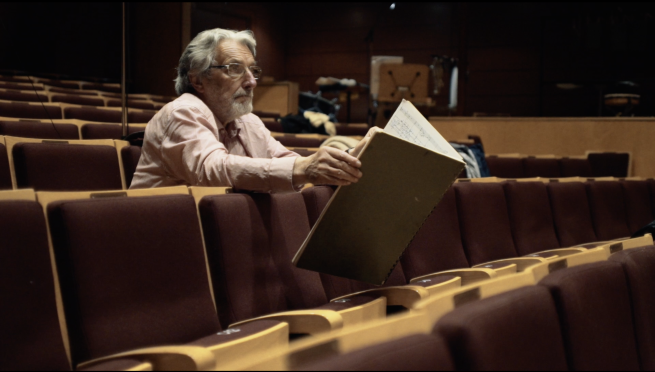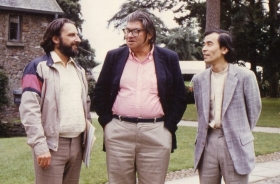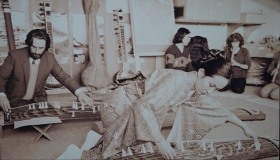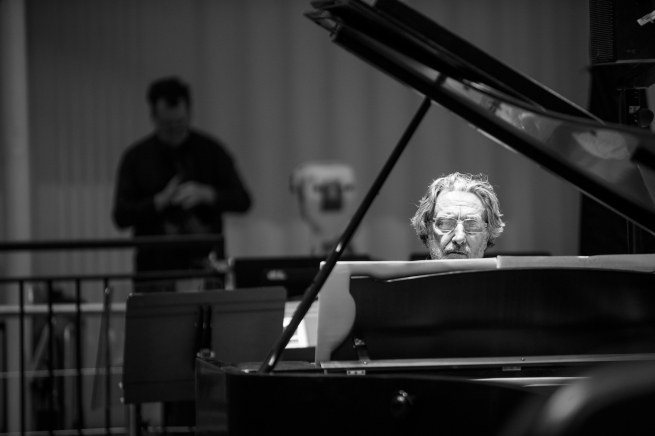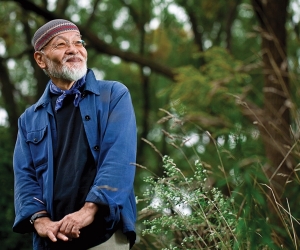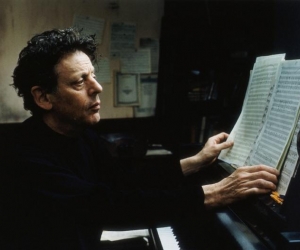“There are power structures that have been to people’s disadvantage, and some of them we belong to, and we must be conscious of that—of course we must be! But that doesn’t mean that we’ve got to separate ourselves into these little boxes.”
Denyer’s travels have also provided poignant glimpses into the universal dimensions of humanity. A brush with tragedy in Ahmedabad, during the India trip, is something he has been contemplating ever since. The city, ravaged by flooding, was littered with corpses and eerily quiet. Amidst all this, he came across a woman hunched in the doorway of a shop, oblivious to the outside world, rocking back and forth, and singing to herself under her breath. “The memory of this voice never left me,” he writes in his book; in different ways, many of his works emulate this fragility. He has even given a name to this phenomenon: the under-voice.
Suhail Merchant reflects: “We all understand there’s a reason music appears in moments like that—moments of trauma, of forgetting oneself, of transcendence, of great emotion, of reverie—just losing yourself in memory.” Music, he continues, “surrounds us in more ways than we may conventionally acknowledge. It’s absent-mindedly hummed under our breath. And it’s strange that something like this should exist, something that seems to have no kind of evolutionary function, or that can’t be explained in particularly logical terms, but it is pervasive, and it is universal. I think Frank’s music is a particular gateway to asking and exploring those questions about music.”
The seeds planted by Yamaguchi’s solo shakuhachi recording began to blossom in 1974, when Denyer left England for Wesleyan University in Connecticut to pursue a doctorate in ethnomusicology, focusing on Japanese music. Tactile learning had always been essential to Denyer’s process of unlocking the worlds encapsulated in various music; at Wesleyan he was able to integrate learning the koto into his program, providing him a means to internalize Japanese repertoire and gesture. By another stroke of luck, the shakuhachi virtuoso Yoshikazu Iwamoto, one of the school’s esteemed artists in residence, was Denyer’s neighbour, and many musical discussions ensued. “He was very anxious that the shakuhachi should be thought of as a contemporary instrument—that it might have roots in Japan but now it was spreading out into the globe,” recalls Denyer.
Iwamoto was intrigued by Denyer’s compositions and mounted a performance of his work Play (1972–73), for two shakuachis and violin. The thought of writing for the musician never occurred to Denyer, though. “His last day in America, I took him to the airport. And he said, ‘Oh, will you write some pieces for me? I don’t mind how difficult they are or if it takes twenty years to learn them. I will learn them.’ For a composer to hear this! Usually [we hear] the opposite: ‘Write me things that sound really difficult, but I haven’t got time to practise,’” he laughs.
Iwamoto’s offer seemed daunting to Denyer, given the instrument’s import to Japanese culture and Buddhism. However, the deft, nimble writing that eventually emerged betrays none of his initial trepidation, bearing no resemblance to traditional repertoire nor other Western implementations of the instrument. Denyer’s ornate microtonal gestures are fluid and otherworldly, like the songs of imaginary birds, as phrases swoop, quiver, and swerve between stark percussive punctuations.
Denyer and Iwamoto cemented their trust over a prolonged cassette-based correspondence during Denyer’s time in Kenya, which started in 1978. Denyer returned to England in 1981, and Iwamoto paid him a surprise visit to refine his interpretations of the new works Denyer had created: On, On, It Must Be So; Wheat; and Quite White.
To date, Denyer has composed nine pieces that feature shakuhachi either as a solo instrument or in ensemble scenarios—many of which were created for Iwamoto. This body of work encompasses the naked sparsity of the forty-seven-minute solo Untitled (1997) to the colourful After the Rain (1983), which flanks the instrument with violin, percussion, and three ocarina players.
Recently, Denyer has been focused on recording Melodies (1974–77), an intense, twenty-five-movement, ninety-minute study in pitch gradations and inflection that Dutch violist Elisabeth Smalt, a longtime collaborator of Denyer’s, calls a masterpiece. Smalt is among the cast of players crafting the document of this intricate, sprawling work. In addition to viola, she also plays an instrument that Denyer devised himself—a fiddle that he calls sneh. Its gourd-shaped body is covered in resonant lizard skin, vaguely resembling its smaller Iranian counterpart, the kamanche.
“I started worrying about the relationship between a note and a frequency,” Denyer says, recalling the gestation of Melodies. “A note, it seems to me, can change frequency. For instance, leading note to a scale, a player might play slightly sharp but it’s still the leading note.” He started with two-note exercises but, overcome with possibilities, reduced his scope to single-note melodies and worked his way back up. Experimentation gave way to composition; over the next three years he developed what he describes as “a kind of self-contained melodic language based on this perception,” unfolding a sequential form that eventually reaches fourteen-note melodies.
Denyer’s notational approach is usually conventional—surprising, perhaps, given the distinct shape and coloration of his music. A rare aberration, Melodies, is represented on staves of varying numbers of lines, foregrounding microtonal pitch relationships over fixed Western pitch identities. It begins with a single-line staff supplemented by ledger lines to denote various deviations and inflections and grows proportionally to the number pitches. “The notation is completely self-invented,” explains Smalt, “so you can’t read it from the score as such. You have to first transcribe it for your instrument or your voice, as it’s based on intervals.”
After 1967, the piano does not appear in Denyer’s catalogue, despite it being his primary instrument. It’s a natural consequence of his fathomless thirst for new sonorities. (“I haven’t gone senile quite yet, but I’m writing another string quartet,” he quips.) Nonetheless, the piano has remained an indispensable exploration tool and a defining feature of his artistic identity. In Merchant’s documentary, Denyer is shown playing Chopin and Bach, which, the filmmaker tells me, is still part of the composer’s daily routine.
After the dissolution of his experimental-music ensemble Mouth of Hermes (1967–1974), Denyer stopped performing until 1982, when trombonist Jim Fulkerson—his colleague at Dartington College—cajoled him into playing some gigs. “I went on the stage, I sat down, and suddenly, I felt so happy,” Denyer recalls. “This is where I want to be. I’m home,” he enthuses. This partnership with Fulkerson laid the groundwork for their later collaboration in Barton Workshop (1989–2010), one of the foremost experimental music ensembles of its time. The group, which Denyer joined in 1992, produced authoritative recordings and concerts of music by Feldman, Wolff, Cage, Ustvolskaya, and Denyer himself. “I remember rehearsals more vividly than I remember concerts, on the whole,” admits Denyer, fondly recalling their rigorous Monday sessions, which were an extension of his ongoing tactile research. “All of us were interested in the problems that [performing experimental music] created,” he says, citing Feldman’s much-touted quiet dynamics. “There’s a level that you have to play to have control and know exactly what is happening, but if you do down below that, there’s an interesting area where you have less control, but very strange things and interesting things happen.”
The beginning of Denyer’s creative process is like a dream. “I know there’s this piece in the vaguest way—I can’t remember this dream, but I can feel the feeling of it,” he says. “[I] see the imagination as something that you follow, and something that you nourish, and you don’t lead. Every time, you ask the imagination. It nourishes itself and it gives you better answers as time goes on. Anytime you deny it, it curls up and dies.”
While his music comes from the depths of his intuition and assumes forms and soundworlds that evoke dreaming, his compositions are also meticulous and lucid in their construction. Yet Denyer also relies on personal relationships to establish the performance practice around his pieces. It’s essential insofar as conveying their quasi-ritualistic tenor.
“Unconventional solutions are always needed for Frank’s music,” Elisabeth Smalt explains. “Frank wants a sound, but he doesn’t say how to get the sound. That’s for the performer to figure out.” Woman, Viola, and Crow—a solo work Smalt has recorded twice—navigates the physical and mental exertion of ultra-quiet viola playing, while determining how to integrate a crow call and the rustling of shells, in terms both of sound and execution. “He is very demanding,” she comments, “And this focus is attractive to me, as an artist. It gives me an existential pleasure to strive so much towards a goal.”
One of Denyer’s most peculiar adjacencies occurs in the surreal Two Voices with Axe (2010), in which a smooth, softly seeping ensemble texture is pitted against the sheer force of someone chopping wood. The performance of the work engenders a natural theatricality. Devices such as the axe, or the acoustic baffling that covers musicians in Screens (his 2017–18 work for female voice, flute, violin, viola, two percussionists, and speaker) never appear for narrative or extra-musical import. They shape the context of the sonic discourse while contributing to it. “Maybe something outside, something beyond where we are, opens up another space—even a different mental space, so we’re not confined to this concert room,” he says.
Some of Denyer’s most compelling works are for larger groups. The Colours of Jellyfish was commissioned for the 2012 Tectonics festival (after much prodding, Denyer tells me) by Ilan Volkov, the fiercest advocate of experimental orchestral music. The work features a spatialized chorus and small orchestra, plus violin and soprano soloists. The Fish that Became the Sun (Songs of the Dispossessed) was composed from 1991 to 1994 but its ambitious scale prevented it from being performed until November 2019, when it received its premiere performance at the Huddersfield Contemporary Music Festival. It is one of Denyer’s most daringly original works as well as one of his best-loved. The panoply of unfamiliar sounds that unfold requires thirty-four performers and over one hundred unique instruments, some scattered throughout the performance venue. Among its cast are child vocalists, a sitar, fishing rods, and eight off-stage cornets—all in a situation that Denyer has likened to the decaying disarray of a rubbish dump.
Instruments designed by Denyer are also part of this piece’s unique instrumental menagerie, among them: repurposed organ-pipes that are played like overgrown recorders, lamella-dyads (enormous two-note thumb pianos), shell-trumpets, and eunuch flutes. Brusque cascades of percussion flail past the listener, weaving through thick, effluvious tone-clouds. Febrile bleating mingles with tender half-remembered folk songs, and delicate microtonal strumming. Its wild boisterousness is offset with moments of breathtaking beauty.
"Composition is a bit like dreaming,” Denyer says. “I say that not in any literal sense, but because one of the peculiarities about dreams is that you can’t decide you’re going to have this kind of dream because they’re interesting. The dreams are given to you; you just have to put up with them.
You don’t know what it is that you’ve done or what significance—or not—it might have for the author or anybody else. So, one is left puzzling about them, as one puzzles over a dream: What is this thing? It’s come into existence through me—I know that—but how and why? I’ve not the slightest clue.”
PHOTOS: Top and bottom photos courtesy of Suhail Merchant. Photo with Morton Feldman and Jo Kondo by Masako Kondo. Photo with Reiko Iwamoto and Yoshikazu Iwamoto courtesy of Frank Denyer. Photo of Denyer at the piano by Tommy Ga-Ken Wan.
ON THE CD: Excerpts from Apocrypha 2, Quartet, Contained in a Strange Garden, Two Female Voices and Two Flutes, String Quartet.
